四级考试重点笔记
- 格式:doc
- 大小:77.50 KB
- 文档页数:6

大学英语四级复习资料(骨灰级整理版)(英语学习)四级复习材料(骨骼级精修版)目录第一部分,听力部分2第二部分,最新英语四级高频词汇23第三部分,四级阅读笔记31 256完形填空测试技巧第五部分36。
翻译经典练习第六部分。
书写七种奇妙的句型199第七部分。
写作必备模板和句型43第八部分。
综合技能培训46第九部分。
作文训练74|第10部分。
英语谚语和格言86滴水逐渐变成大海。
第一块石头移到泰山的第一部分。
听力部分1。
听力内容1。
第一部分对话个短对话(5分02秒)8个对话:4分12秒长对话(5分58秒)个对话1 (4个问题) :对话内容(1分45秒)+问题(1分25秒)对话2 (3个问题):对话内容(1分45秒)+问题(1分02秒)2 .第二部分短文(10分05秒)方向:35秒2 :文章内容(1分25秒)+问题(1分10秒)短文2 (3个问题):文章内容(2分25秒)+问题(1分10秒)短文3 (4个问题):文章内容(1分45秒)+问题(1分55秒)3 . c部分复合听写(11分钟XXXX年,时间,数字,金钱(2)抓住两句1)听到结尾->回忆一两句的结尾2)重复词(重复词是文章的重点内容),同时,它表示文章即将结束。
3)因此,因此,因此,都暗示着文章即将结束。
(3)抓住中间的小单词1)记住以下七个小单词:首先,大多数,因为出现,99%会给出试题只是,还会给考题。
但是,也会给考试题。
(2)频繁测试的逻辑关系:并列:因果:因为转折:但是,递进:越多,让步越多:尽管,尽管,如果你没有听清楚文章的内容,你必须听清楚问题,然后用常识判断4的对错。
问题(1)主观态度问题:说出事实并选择积极的态度(也就是说,选择积极的、值得称赞的和良好的态度)演讲者对某事的态度是什么?演讲者对某事的印象如何?主观态度问题通常不会测试太详细的选项(也就是说,太精确的选项通常被用来迷惑人)(2)中心思想问题什么文章?这篇文章的主旨是什么?这篇文章的主题是什么?(3)释义替换题。
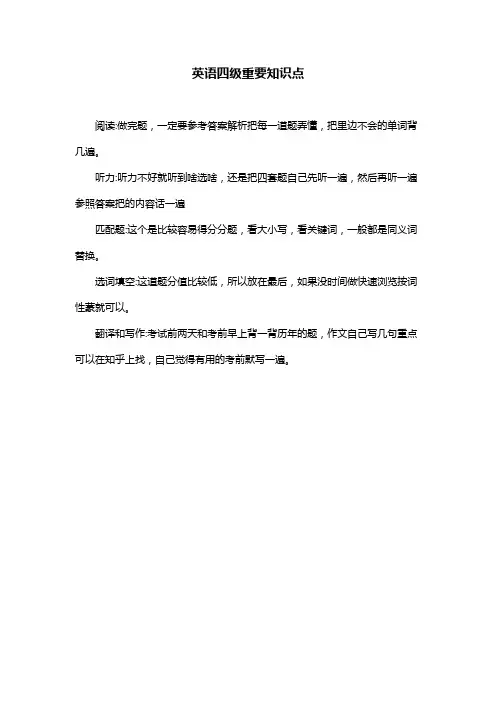
英语四级重要知识点
阅读:做完题,一定要参考答案解析把每一道题弄懂,把里边不会的单词背几遍。
听力:听力不好就听到啥选啥,还是把四套题自己先听一遍,然后再听一遍参照答案把的内容话一遍
匹配题:这个是比较容易得分分题,看大小写,看关键词,一般都是同义词替换。
选词填空:这道题分值比较低,所以放在最后,如果没时间做快速浏览按词性蒙就可以。
翻译和写作:考试前两天和考前早上背一背历年的题,作文自己写几句重点可以在知乎上找,自己觉得有用的考前默写一遍。

英语四级的知识点归纳英语四级是中国大学英语四级考试的简称,也被称为CET-4。
它是中国教育部主管的一项国家级英语考试,旨在评估学生在英语听、说、读、写能力方面的水平。
下面将详细介绍英语四级考试的知识点。
一、听力理解(Listening Comprehension)英语四级考试的听力理解部分主要测试考生对于英语口语及常用语和词汇的理解能力。
考生需要听取短文、对话或独白,并回答相关问题。
1. 答案抓取:在听取录音时,考生需要仔细听取关键信息,如人名、地点、数字等,以便在听完后正确抓取答案。
2. 推理判断:在听到短文或对话后,考生需要根据所听内容进行推理和判断,回答相关问题。
3. 笔记总结:考生需要在听取短文或对话时做好笔记,记录重要的信息,以便后续回答问题使用。
二、阅读理解(Reading Comprehension)英语四级考试的阅读理解部分主要测试考生对于英语文章的理解和分析能力。
考生需要阅读文章,理解文章的大意和细节,并回答相关问题。
1. 主旨概括:考生需要通过阅读全文,理解文章的主旨和中心思想。
2. 细节理解:考生需要根据所给问题,找出文章中与之相关的具体细节。
3. 词汇理解:考生需要理解文章的生词和短语的意思,并根据上下文推测其含义。
4. 推理判断:考生需要根据文章内容进行推理和判断,回答与文章相关的问题。
三、写作(Writing)英语四级考试的写作部分主要测试考生的写作能力,包括对于英语语法和词汇的正确运用,以及论述能力。
1. 作文写作:考生需要根据所给话题,完成一篇短文写作。
作文要求清晰明确,结构合理,内容连贯。
2. 语法和词汇:考生需要在写作时正确运用英语语法和词汇,注意句子结构和单词拼写的正确性。
3. 论述能力:考生需要在写作中能够有条理地陈述自己的观点,并给出充分的论据和例证支持。
四、翻译(Translation)英语四级考试的翻译部分主要测试考生从中文翻译成英文和从英文翻译成中文的能力。

大学英语四级考试语法笔记46The question is where to go for help. 问题是到哪里求助。
To respect others is to be respected. 尊重别人就是受到别人的尊重。
To see her is to love her. 见到她就会爱上她。
(五)不定式短语和疑问词连用(who, whom, whose, what, which, when, where, how,还包括whether)(1)做主语。
例如:Who to turn to is what she wants to know. 找谁帮忙是她想知道的。
It’s problem what to do. 干什么还是个问题。
How to be wealthy, healthy and happy will always remain a question mark. 怎样才能富有,健康和幸福将永远是个问号。
(2)做表语。
例如:The question is which to take first. 问题是先拿哪一个。
What remains for you to explain is how to put the plan into practice and whose help to seek. 剩下需要你解释的是怎样实施计划以及寻求谁的帮助。
The question is which of the methods to adopt. 问题是采取这些方法中的哪一个。
(3)作宾语,常用这一结构作宾语的动词有ask, consider, decide discuss, explain, forget, find out, guess, inquire, know, learn, remember, see(=understand), show, settle(=decide), tell(=know), think, understand, wonder等。


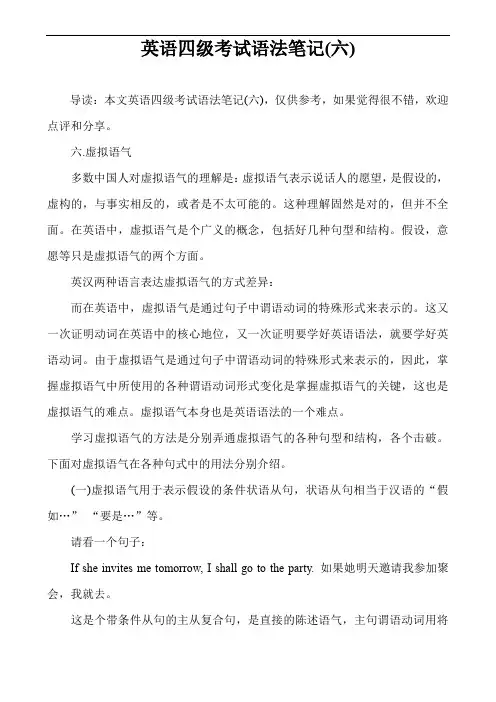
英语四级考试语法笔记(六)导读:本文英语四级考试语法笔记(六),仅供参考,如果觉得很不错,欢迎点评和分享。
六.虚拟语气多数中国人对虚拟语气的理解是:虚拟语气表示说话人的愿望,是假设的,虚构的,与事实相反的,或者是不太可能的。
这种理解固然是对的,但并不全面。
在英语中,虚拟语气是个广义的概念,包括好几种句型和结构。
假设,意愿等只是虚拟语气的两个方面。
英汉两种语言表达虚拟语气的方式差异:而在英语中,虚拟语气是通过句子中谓语动词的特殊形式来表示的。
这又一次证明动词在英语中的核心地位,又一次证明要学好英语语法,就要学好英语动词。
由于虚拟语气是通过句子中谓语动词的特殊形式来表示的,因此,掌握虚拟语气中所使用的各种谓语动词形式变化是掌握虚拟语气的关键,这也是虚拟语气的难点。
虚拟语气本身也是英语语法的一个难点。
学习虚拟语气的方法是分别弄通虚拟语气的各种句型和结构,各个击破。
下面对虚拟语气在各种句式中的用法分别介绍。
(一)虚拟语气用于表示假设的条件状语从句,状语从句相当于汉语的“假如…”“要是…”等。
请看一个句子:If she invites me tomorrow, I shall go to the party. 如果她明天邀请我参加聚会,我就去。
这是个带条件从句的主从复合句,是直接的陈述语气,主句谓语动词用将来时,从句谓语动词用现在时代替将来时,表示能实现的动作。
这句话说明说话人认为邀请的可能性较大。
此句的条件是“只要她邀请我”,“去”这一动作就能实现。
请把这句话与下面虚拟语气的带条件从句的主从复合句进行比较:1) If she invited me, I should go to the party. 假如她邀请我参加聚会,我就去。
(说话人认为邀请的可能性较小或不可能。
)这句话主句谓语动词用过去将来时,从句谓语动词用一般过去时,其含义是:She will probably not invite me, so I shall not go to the party. 她很可能不会邀请我参加聚会,所以我不会去。
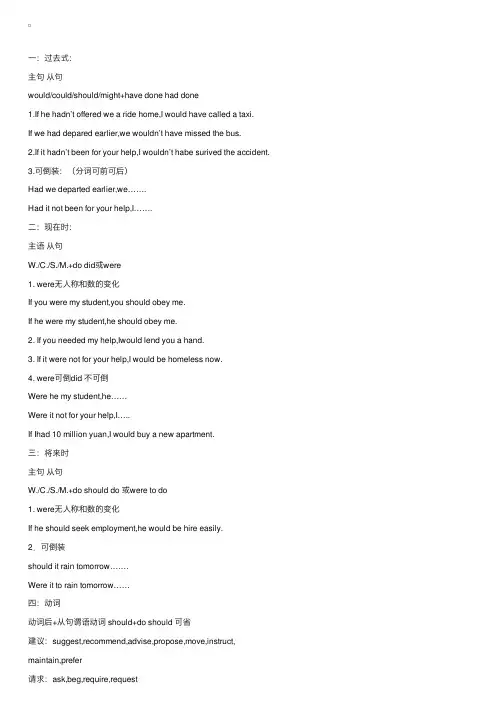
⼀:过去式:主句从句would/could/should/might+have done had done1.If he hadn’t offered we a ride home,I would have called a taxi.If we had depared earlier,we wouldn’t have missed the bus.2.If it hadn’t been for your help,I wouldn’t habe surived the accident.3.可倒装:(分词可前可后)Had we departed earlier,we…….Had it not been for your help,I…….⼆:现在时:主语从句W./C./S./M.+do did或were1. were⽆⼈称和数的变化If you were my student,you should obey me.If he were my student,he should obey me.2. If you needed my help,Iwould lend you a hand.3. If it were not for your help,I would be homeless now.4. were可倒did 不可倒Were he my student,he……Were it not for your help,I…..If Ihad 10 million yuan,I would buy a new apartment.三:将来时主句从句W./C./S./M.+do should do 或were to do1. were⽆⼈称和数的变化If he should seek employment,he would be hire easily.2.可倒装should it rain tomorrow…….Were it to rain tomorrow……四:动词动词后+从句谓语动词 should+do should 可省建议:suggest,recommend,advise,propose,move,instruct, maintain,prefer请求:ask,beg,require,request打算,愿望:decide,determine,intend,desire,assume命令:arrange,direct,command,order其他:urge,agree,hint,insist,promiseHe urged the library should stay open during summer vocation.He assumed he would be selected chairman of the committee.五:形容词从句谓语动词should +do,should 可省It’s important to acquire professional knowledge and skill.It’s important for us to acquire…..It’s important that we should…..·essential,fundamental,important,vital,necessary,imperative,better,best,appropriate,probable,expedient,natural·desirable,advisable,urgent,preferable·strange,odd,amazing,astonishing,surprising,shocked,pitiful,sorry,ridiculous,absurd,unthinkable,incredible,interesting,annoying1.It’s imperative that we should hold a meeting to settle the problem.2.It’s advisable that another university be set up.3.I’m sorry that he should feel that way.六:名词从句谓语动词should+do ,should可省1.They made a motion that he should compensate for their loss.2.It is of great importance that we should made plans to beautify out city.2.We’re all for your proposal that the discussion.be put off七:连词。
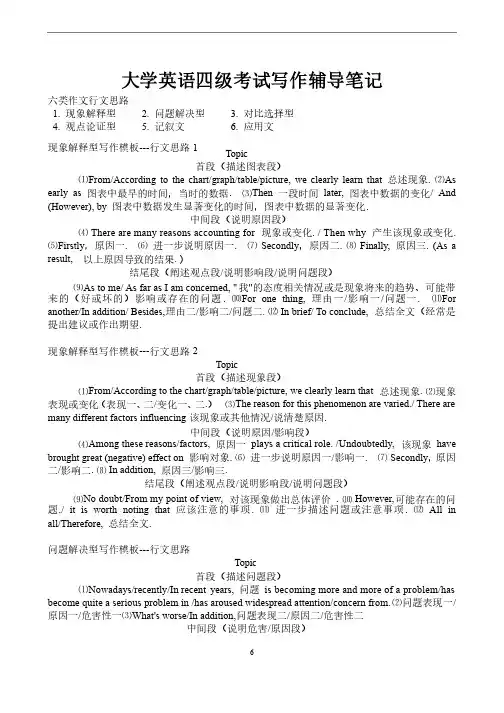
6大学英语四级考试写作辅导笔记六类作文行文思路六类作文行文思路1. 现象解释型现象解释型2. 问题解决型问题解决型3. 对比选择型对比选择型4. 观点论证型观点论证型5. 记叙文记叙文6. 应用文应用文现象解释型写作模板---行文思路1 Topic首段(描述图表段)首段(描述图表段)⑴From/According to the chart/graph/table/picture, we clearly learn that 总述现象. ⑵Asearly as 图表中最早的时间,当时的数据. ⑶Then 一段时间一段时间later, 图表中数据的变化/ And (However), by 图表中数据发生显著变化的时间,图表中数据的显著变化.中间段(说明原因段)中间段(说明原因段)⑷ There are many reasons accounting for 现象或变化. / Then why 产生该现象或变化.⑸Firstly ,原因一. ⑹ 进一步说明原因一. ⑺Secondly ,原因二. ⑻ Finally, 原因三. (As a result, 以上原因导致的结果. )结尾段(阐述观点段/说明影响段/说明问题段)说明问题段)⑼As to me/ As far as I am concerned, "我"的态度相关情况或是现象将来的趋势、可能带来的(好或坏的)影响或存在的问题. ⑽For one thing, 理由一/影响一/问题一. ⑾Foranother/In addition/ Besides,理由二/影响二/问题二. ⑿ In brief/ To conclude, 总结全文(经常是提出建议或作出期望.现象解释型写作模板---行文思路2Topic首段(描述现象段)首段(描述现象段)⑴From/According to the chart/graph/table/picture, we clearly learn that 总述现象. ⑵现象表现或变化(表现一、二/变化一、二.) ⑶The reason for this phenomenon are varied./ There aremany different factors influencing 该现象或其他情况/说清楚原因.中间段(说明原因/影响段)影响段)⑷Among these reasons/factors, 原因一原因一 plays a critical role. /Undoubtedly, 该现象该现象have brought great (negative) effect on 影响对象. ⑹ 进一步说明原因一/影响一. ⑺ Secondly ,原因二/影响二. ⑻ In addition, 原因三/影响三.结尾段(阐述观点段/说明影响段/说明问题段)说明问题段)⑼No doubt/From my point of view, 对该现象做出总体评价对该现象做出总体评价. ⑽ However,可能存在的问题./ it is worth noting that 应该注意的事项. ⑾ 进一步描述问题或注意事项. ⑿All in all/Therefore, 总结全文.问题解决型写作模板---行文思路行文思路Topic首段(描述问题段)首段(描述问题段)⑴Nowadays/recently/In recent years, 问题问题is becoming more and more of a problem/has become quite a serious problem in /has aroused widespread attention/concern from.⑵问题表现一/原因一/危害性一⑶What's worse/In addition,问题表现二/原因二/危害性二危害性二中间段(说明危害/原因段)原因段)⑷ It is very clear that 该问题该问题 is bringing great harm to 危害对象危害对象/There are many factors resulting in 该问题该问题 / ⑸Above all, 危害一/Among these 原因一原因一plays a vital role.⑹ 进一步说明危害/原因一. ⑺ What's more ,危害二/原因二.结尾段(说明方法段)结尾段(说明方法段)⑻Considering the seriousness of 该问题, it is an urgent thing for us to take effectivemeasures to 解决该问题. ⑼First of all 方法一.⑽进一步阐述方法一/Secondly,方法二.⑾Thirdly/In addition,方法三. ⑿ Only through these ways, can the problem be solved./To conclude,it is everyone's responsibility to take effort to solve the problem.对比选择型写作模板---行文思路1Topic首段(提出观点段)首段(提出观点段)⑴When it comes to 谈论主题, there is no complete agreement among people/differentpeople will offer different ⑵Some people take it for granted/believe 一种观点/选择⑶However,others maintain /prefer 另一种观点另一种观点/选择. 中间段(对比论证段)中间段(对比论证段)⑷ Those people who hold the first opinion/make the former choice believe 观点/选择一的理由一. ⑸ (In addition,) in their eyes, they maintain/point out 观点/选择一的理由二. ⑹ However,still others think differently/ do not agree this. ⑺In their opinions, 观点/选择二的理由一. ⑻Besides, they argue 观点/选择二的理由二.结尾段(总结观点段)结尾段(总结观点段) ⑼Weighing up these two argument/choices/preferences, I prefer/am inclined to theformer/the latter one/"我"的选择.⑽ For one thing,理由一. ⑾ For another/What's more,理由二. ⑿Taking above-mentioned factors into consideration, we/ I may reasonably conclude/suggest 重申观点. / In a word, 提出建议.对比选择型写作模板---行文思路2Topic首段(提出观点段)首段(提出观点段)⑴Nowadays/In recent years, 一种现象. ⑵Some people 一些人的看法或做法,while others, 另一些人地看法或做法. ⑶ As to me, I prefer to/ am in favor of the former/latter.中间段(反面论证段)中间段(反面论证段)⑷ Of course, "我"不赞同观点的合理性. ⑸ For example, 支持其合理性的例./进一步阐述其合理性. ⑹ But it doesn't mean/it is worth noting that "我" 不赞同不赞同观点的不足. ⑺From my point of view/In my view, 我的不同观点.结尾段(正面论证段)结尾段(正面论证段)⑻The following reasons can account for/contribute to/support my argument. ⑼ First,理由一. ⑽ A good example to illustrate,支持理由一的例子/进一步说明理由一. ⑾ Second, 理由二.⑿ To conclude/From the foregoing,重申观点.观点论证型写作模板---行文思路行文思路Topic首段(提出观点段)首段(提出观点段)⑴Nowadays still many people believe/For years many people have such thought that 与论点冲突的背景观点或现象.⑵进一步说明背景观点或现象. ⑶However, 论点. ⑷The following reasons can support the argument.中间段(说明危害/原因段)原因段)⑸Undoubtedly, 论据一. ⑹进一步说明论据一. ⑺ Furthermore/Moreover,论据二. ⑻ For example ,支持论据二的事例/进一步说明论据二. ⑼ In addition/ What's more, 论据三.结尾段(总结观点段)结尾段(总结观点段)⑽ All mentioned above tell that 重申观点. ⑾ 进一步阐述论点. ⑿Therefore, we should正确态度或做法.记叙文写作模板---行文思路1Topic首段(描述背景段)首段(描述背景段)⑴背景事件⑴背景事件will come soon, 事件的重要性或意义.⑵There is no more appropriate time than this for 相关人员的态度或行动.⑶So on this special occasion, 我的愿望或打算.中间段(叙述经过段)中间段(叙述经过段)⑷ Now I still remember clearly 主题事件. ⑸Firstly ,原因一. ⑹ 进一步说明原因一.⑺Secondly ,原因二. ⑻ Finally, 原因三. (As a result, 以上原因导致的结果. )结尾段(阐述观点段)结尾段(阐述观点段) ⑼As to me/ As far as I am concerned, “我”的态度相关情况或是现象将来的趋势、可能带来的(好或坏的)影响或存在的问题. ⑽For one thing, 理由一/影响一/问题一. ⑾Foranother/In addition/ Besides,理由二/影响二/问题二. ⑿ In brief/ To conclude, 总结全文(经常是提出建议或作出期望.)记叙文写作模板---行文思路2Topic首段(描述背景段)首段(描述背景段)⑴简要介绍事件发生的时间, I witnessed 总述目击事件.⑵ 事件给人印之处, which isstill vivid in my mind./该事件was so 事件的突出特点that I was left a deep impression.中间段(叙述经过段)中间段(叙述经过段) ⑶It was/happened 事件开始时间,when 当时的情形. ⑷ ( Suddenly, ) 事件的发展一. ⑸ 事件的发展二. ⑹ 事件的发展三. ⑺As a result, 事件的最终结果或影响.结尾段(阐述观点段)结尾段(阐述观点段)⑻ 总述该事件带来的影响/事件产生的原因.⑼For one thing, 影响一/原因一/措施一. ⑽进一步说明影响一/原因一/措施一. ⑾For another, 影响二/原因二/措施二. ⑿Therefore, 总结全文(提出建议或作出期望).Or Such an incident teaches us an important moral, that is “我的感受或得到的启示. 感受一/行动一. Furthermore,感受二/行动二. In conclusion,I do believe that 总结全文。

359. terminal a. 末端的,极限的 n. 终点360. territory n. 领⼟361. approximate a. ⼤概的,⼤约 v. 近似362. arbitrary a. 随意的,未断的363. architect n. 建筑师364. architecture n. 建筑学365. biology n. ⽣物学366. geography n. 地理(学)367. geology n. 地质学368. geometry n. ⼏何(学)369. arichmetic n. 算术370. algebra n. 代数371. entertainment n. 娱乐;招待,款待372. enthusiasm n. 热情,热⼼373. entry n. 进⼊,⼊⼝处;参赛的⼈(或物)374. enviroment n. 环境375. episode n. 插曲,⽚段376. equation n. ⽅程(式)377. restrain vt. 阻⽌,抑制378. restraint n. 抑制,限制379. resume v. (中断后)重新开始380. severe a. 严重的381. sexual a. 性的382. simplicity n. 简单;朴素383. simplify vt. 简化384. sorrow n. 悲哀,悲痛385. stuff n. 原料,材料 vt. 填进,塞满386. temporary a. 暂时的,临时的387. temptation n. 诱惑,引诱388. terror n. 恐怖389. thrust v. 挤,推,插390. treaty n. 条约,协定391. arise vi. 产⽣,出现,发⽣;起⾝392. arouse vt. 引起,激起;唤醒393. burden n. 重担,负荷394. bureau n. 局,办事处395. marveous a. 奇迹般的,惊⼈的396. massive a. ⼤的,⼤量的,⼤块的397. mature a. 成熟的398. maximum a. 的,的399. minimum a. 最低的,最⼩的400. nonsense n. 胡说,冒失的⾏动401. nuclear a. 核⼦的,核能的402. nucleus n. 核403. retail n./v./ad. 零售404. retain vt. 保留,保持405. restrict vt. 限制,约束406. sponsor n. 发起者,主办者 vt. 发起,主办,资助407. spur n./vt. 刺激,激励408. triumph n. 胜利,成功409. tuition n. 学费410. twist vt. 使缠绕;转动;扭歪411. undergraduate n. ⼤学肄业⽣412. universal a. 普遍的,通⽤的;宇宙的413. universe n. 宇宙414. via prep. 经由,经过,通过415. vibrate v. 振动,摇摆416. virus n. 病毒417. voluntary a. ⾃愿的418. volunteer n. 志愿者 v. ⾃愿(做)419. vote v. 选举 n. 选票420. wagon n. 四轮马车,铁路货车421. appoint vt. 任命,委派422. approach v. 靠近,接近 n. 途径,⽅式423. appropriate a. 适当的424. bunch n. 群,伙;束,串425. bundle n. 捆,包,束 vt. 收集,归拢426. ceremony n. 典礼,仪式427. chaos n. 混乱,紊乱428. discount n. (价格)折扣429. display n./vt. 陈列,展览430. equivalent a. 相等的 a. 相等物431. erect a. 竖直的 v. 建造,竖⽴432. fax n./vt. 传真433. ferfile a. 肥沃的;多产的434. fertilizer n. 肥料435. grateful a. 感激的436. gratitude n. 感激437. horror n. 恐怖438. horrible a. 可怕的439. Internet n. 国际互联,因特440. interpret v. 翻译,解释441. interpretation n. 解释,说明442. jungle n. 丛林,密林443. knot n. 结 vt. 把...打成结444. leak v. 漏,渗出445. lean vi. 倾斜,倚,靠446. leap vi. 跳跃447. modify vt. 修改448. nylon n. 尼龙449. onion n. 洋葱450. powder n. 粉末451. applicable a. 可应⽤的,适当的452. applicant n. 申请⼈453. breadth n. 宽度454. conservation n. 保存,保护455. conservative a. 保守的456. parallel n. 平⾏线;可相⽐拟的事物457. passion n. 激情,热情458. passive a. 被动的,消极的459. pat v./n. 轻拍,轻打460. peak n. ⼭峰,顶点461. phenomenon n. 现象462. reluctant a. 不情愿的,勉强的463. rely vi. (on ,upon)依赖,指望464. relevant a. 有关的,切题的465. reliable a. 可靠的466. relief n. 轻松,宽慰;减轻467. reputation n. 名⽓,声誉468. rescue vt./n. 营救469. triangle n. 三⾓(形)470. sequence n. 连续;顺序471. shallow a. 浅的472. shiver vi/n. 发抖473. shrug v./n. 耸肩474. signature n. 签名475. sincere a. 诚挚的,真诚的476. utilify n. 功⽤,效⽤477. utilise vt. 利⽤478. utter vt. 说出 a. 完全的,彻底的479. variation n. 变化,变动480. vehicle n. 交通⼯具,车辆481. applause n. ⿎掌,掌声482. appliance n. 器具,器械483. consent n. 准许,同意 vi (to)准许,同意484. conquer vt. 征服485. defect n. 缺点,缺陷486. delicate a. 易碎的;娇弱的;精美的487. evolve v.演变488. evolution n. 演变,进化489. frown v./n. 皱眉490. frustrate vt. 使沮丧491. guarantee vt./n. 保证492. guilty a. 内疚的;有罪的493. jealous a. 妒忌的494. jeans n. ⽜仔裤495. liquor n. 酒,烈性酒496.liter/litre n. 升497. modest a. 谦虚道498. molecule n. 分⼦499. orbit n. 轨道 v. (绕...)作轨道运⾏500. participate v. (in)参与,参加501. particle n. 微粒502. particularly ad. 特别,尤其503. respond vi. 回答,答复;反应504. response n. 回答,答复;反应505. sensible a. 明智的506. sensitive a. 敏感到,灵敏的507. tremble vi. 颤抖508. tremendous a. 巨⼤的;精彩的509. trend n. 趋向,倾向510. trial n. 审讯;试验511. apparent a. 显然的,明⽩的512. appetite n. 胃⼝;欲望513. deposit n. 存款,定⾦ v.存放,储蓄514. deputy n. 副职,代表515. derive vt. 取得,得到;(from)起源于516. descend v. 下来,下降517. missile n. 导弹518. mission n. 使命;代表团519. mist n.薄雾520. noticeable a. 显⽽易见到521. notify vt. 通知,告知522. notion n. 概念;意图,想法523. resemble vt. 像,类似于524. reveal vt. 揭露525. revenue n. 收⼊,岁⼊;税收526. shelter n. 掩蔽处;住所527. shield n. 防护物,盾 vt. 保护,防护528. vital a. 重要的;致命的,⽣命的529. vitally ad. 极度,⾮常;致命地530. urban a. 城市的531. urge vt. ⿎励,激励532. urgent a. 急迫的,紧急得533. usage n. 使⽤,⽤法534. violence n. 强⼒,暴⼒535. violent a. 强暴的536. violet a. 紫⾊的537. weed n. 杂草,野草538. welfare n. 福利539. whatsoever ad. (⽤于否定句)任何540. whereas conj. 然⽽,但是,尽管541. essential a. 必不可少的;本质的542. estimate n./vt. 估计,估量543. evaluate vt. 评估,评价544. exceed vt. 超过,越出545. exceedingly ad. ⾮常,极其546. exclaim v. 呼喊,⼤声说547. exclude vt. 把...排斥在外,不包括548. exclusive a. 读有的,排他的549. excursion n. 远⾜550. flash vi. 闪光,闪耀551. flee vi. 逃⾛552. flexible a. 易弯曲的553. flock n. ⽺群,(鸟兽等)⼀群;⼀伙⼈554. hardware n. 五⾦器具555. harmony n. 和谐,融洽556. haste n. 急速,急忙557. hatred n. 憎恶,憎恨558. incident n. 事件,事变559. index n. 索引,标志560. infant n. 婴⼉561. infect v. 传染562. inferior a. 劣等的,次的,下级的563. infinite a. ⽆限的564. ingredient n. 组成部分565. inhabitant n. 居民566. jail n. 监狱567. jam n. 果酱;拥挤,堵塞568. jewel n. 宝⽯569. joint a.连接的;共同的570. junior a. 年少的;资历较浅的571. laser n. 激光572. launch vt. 发动,发起573. luxury n. 奢侈;奢侈品574. magnet n. 磁铁,磁体575. male a. 男性的,雄的576. female a. ⼥性的,雌的577. manual a. ⽤⼿的,⼿⼯做的 n. ⼿册578. manufacture vt./n. 制造,加⼯579. marine a. 海的;海产的580. mutual a. 相互的581. naked a. *露的582. negative a. 否定的,消极的583. neglect vt. 忽视,忽略584. origin n. 起源,出⾝585. oval a. 椭圆形的 n. 椭圆形586. outset n. 开始,开端587. presumably ad. ⼤概,可能588. prevail vi. 流⾏,盛⾏589. quit v. 停⽌590. quotation n. 引⽂,引语591. recreation n. 娱乐活动592. recruit vt. 招募,吸收(新成员)593. rival n. 竞争对⼿,敌⼿594. shuttle n. 梭⼦;航天飞机595. skim vt. 搬(去),掠过;浏览596. sketch n. 草图;梗概597. slender a. 苗条的,修长的598. theme n. 主题599. textile n. 纺织品600. tropical a. 热带的,炎热的601. kneel vi. 跪602. label n. 标签603. merchant n. 商⼈604. mere a. 仅仅的,只不过的;纯粹的605. nuisance n. 令⼈讨厌的东西(或⼈)606. numerrous a. 众多的,许多的607. parade n. * v. 列队⾏进608. pants[pl.] n. 长裤;内裤609. partial a. 部分的610. passport n. 护照611. prescribe vt. 开药,吩咐采⽤...疗法612. primitive a. 原始的,早期的613. ridge n. 脊,⼭脊,埂614. ridiculous a. 可笑的,荒漠的615. ridid a. 严格的;僵硬的616. withstand vt. 经受,承受617. witness n. ⽬击者;证据 vt. 注意到;证明618. withdraw v. 收回,撤销619. slippery a. 滑的620. smash vt. 粉碎,打烂621. snap n./vt. 折断,拉断;快照622. software n. 软件623. solar a. 太阳的624. lynar a. ⽉的,⽉球的625. submerge vi. 潜⼊⽔中626. submit vi.(to)屈服,听从627. timber n. ⽊材,原⽊628. tissue n. 组织;薄纱,⼿⼱纸629. title n. 题⽬,标题630. tone n. 语⽓,⾳调631. drift vi. 漂,漂流632. drip n. 滴633. durable a. 耐⽤的,持久的634. duration n. 持续,持续期间635. dusk n. 黄昏,薄暮636. leather n. ⽪⾰637. legislation n. 法律,法规;⽴法638. leisure n. 闲暇;悠闲639. loose a. 松的,宽松的640. loosen v. 解开,放松641. tarnest a. 认真的,诚挚的642. earthquake n. 地震643. echo n. 回⾳,回声644. elaborate a. 精⼼设计的,复杂的645. elastic n. 橡⽪圈(带) a. 有弹性的646. elbow n. 肘647. electron n. 电⼦648. volcano n. ⽕⼭649. volume n. 卷,册;体积,容量650. fatigue n. 疲劳,劳累651. faulty a. 有错误的,有缺点的652. favorable a. 称赞道;有利的,顺利的653. favorite a. 特别受喜欢的 n. 喜爱的⼈或物654. gallery n. 画廊655. gallon n. 加仑656. gap n. 间隔,差距657. garbage n. 垃圾,废物658. gaze v. 凝视,注视659. gear n. 齿轮,传动装置660. gene n. 基因661. lest conj. 唯恐,免得662. liable a. 可能的,⼤概的; (to)易于...的663. liberal a. ⾃由得664. liberty n. ⾃由665. licence/license n. 许可证,执照666. moisture n. 潮湿667. motivate vt. 激励,激发668. motive n. 动机,⽬的669. generate vt. ⽣成,产⽣(光、热、电等)670. genius n. 天才,天赋671. genuine a. 真的,真诚的672. gasoline n. 汽油673. germ n. 微⽣物,细菌674. gesture n. 姿势,⼿势675. giant a. 巨⼤的 n. 巨⼈,巨物676. glimpse n. ⼀瞥,⼀看677. glory n. 光荣,荣誉678. glorious n. 光荣的,极好的679. golf n. ⾼尔夫球运动680. hydrogen n. 氢681. oxygen n. 氧682. hostile a. 敌对的,敌意⼤683. household n. 家庭,户684. hook n. 钩685. holy a. 神圣地,圣洁的686. hint n. 暗⽰,⽰意687. hestiate v. 犹豫688. highlight vt. 强调,突出689. hence ad. 因此,所以;今后,从此690. herd n. 兽群,牧群。
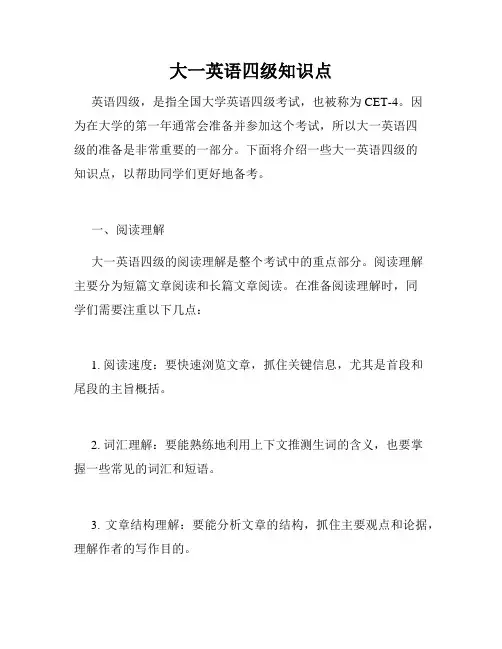
大一英语四级知识点英语四级,是指全国大学英语四级考试,也被称为CET-4。
因为在大学的第一年通常会准备并参加这个考试,所以大一英语四级的准备是非常重要的一部分。
下面将介绍一些大一英语四级的知识点,以帮助同学们更好地备考。
一、阅读理解大一英语四级的阅读理解是整个考试中的重点部分。
阅读理解主要分为短篇文章阅读和长篇文章阅读。
在准备阅读理解时,同学们需要注重以下几点:1. 阅读速度:要快速浏览文章,抓住关键信息,尤其是首段和尾段的主旨概括。
2. 词汇理解:要能熟练地利用上下文推测生词的含义,也要掌握一些常见的词汇和短语。
3. 文章结构理解:要能分析文章的结构,抓住主要观点和论据,理解作者的写作目的。
4. 题目类型:要了解不同类型的题目,如主旨题、细节题、推理题等,逐一进行针对性的练习。
二、听力大一英语四级的听力考试通常会有长对话和短文听力。
在准备听力时,同学们要注意以下几点:1. 预测信息:在听对话或短文之前,要根据题目提供的关键词或问题,设想可能出现的答案,以提前预测信息。
2. 注意听关键词:在听对话或短文时,要特别注意关键词和数字等重要信息,记下来以备后续使用。
3. 笔记技巧:可以使用简洁的符号或关键词进行记录,帮助记忆和理解听到的内容。
4. 听力材料复述:在听完对话或短文后,可以尝试将听到的内容用自己的话复述一遍,以巩固记忆并提高听力理解能力。
三、写作大一英语四级的写作考试通常要求写作短文,包括图表作文、观点/论述类作文等。
在准备写作时,同学们需要注意以下几点:1. 语言表达:要注意使用正确的语法和词汇,注意句子结构的多样性,尽量避免使用简单的句式和常见的词汇。
2. 逻辑关系:要注意段落之间的逻辑关系,保证篇章条理清晰,内容连贯。
3. 观点与论证:要能够清晰地表达自己的观点,并用合适的论据进行支持和论证。
4. 练习写作:要多做一些写作练习,特别是以往的真题作文。
可以结合老师的指导和阅读一些范文,积累写作技巧和素材。
【四级】人力资源管理师考试第一至六章考点重点自学笔记人力资源管理师四级专业技能教材第一章第一章人力资源规划1.人力资源规划内容(1)战略规划;(2)组织规划;(3)制度规划;(4)人员规划;(5)费用规划。
2.企业组织信息采集和处理的基本原则(1)准确性原则;(2)系统性原则;(3)针对性原则;(4)及时性原则;(5)适用性原则;(6)经济性原则。
3.按劳动定额的表现形式分类(1)时间定额。
(2)产量定额。
(3)看管定额。
(4)服务定额。
(5)工作定额。
(6)人员定额。
(7)其他。
如销售定额。
4.劳动定额的影响因素(1)与设备、工具有关:数量、性质、使用情况。
(2)与生产情况、生产过程有关:不能月初松月底紧。
(3)与操作方法有关:规程是否合理、工人是否遵守劳动力的配备。
(4)与组织有关:技术工人和普通工人的配备、分工协作情况;工人等级与工作物等级的配合情况。
(5)与工作地有关:布置、光线、通信、温度。
(6)与各种规章制度及其他有关。
5.工作岗位研究的原则(1)系统的原则。
四个基本特征:整体性、目的性、相关性、环境适应性。
具体形态表现为:自然系统与人造系统;实体系统与概念系统;报考系统和静态系统;开发系统与封闭系统。
(2)能级的原则。
能级是指组织机构中各个岗位功能的等级,也就是岗位在组织机构这个“管理场”中所具有的能量等级。
一个岗位能级的大小,由它在组织中的工作性质、复杂难易程度、责任大小、任务轻重等因素决定。
(3)标准化原则。
标准化是现代企业人力资源管理的基础,也是有效地推行各项管理的重要手段。
(4)最优化原则。
最优化是指在一定约束条件下,使系统的目标函数达到最大值或最小值。
如:以最低数量岗位设置,谋求总体的高效率化。
6.作业测时功能(1)为制定工时定额提供数据资料;(2)总结和推广先进员工的操作方法和先进经验,帮助后进,使操作方法合理化、科学化,减轻员工体力消耗和劳动强度;(3)分析和研究多机台看管和生产流水线的节拍,合理确定各工作岗位的劳动负荷量,改善劳动组织,提高劳动生产率;(4)为掌握岗位的劳动负荷量,以及进行体力劳动强度分级提供依据;(5)弥补岗位写实无法获得的工时数据资料。
洛基英语,中国在线英语教育领导品牌例如:I shall be twenty years old next year. 我明年二十岁。
The sky is black. I think it will rain. 天黑下来了。
我想可能会下雨。
You will meet him at the station this afternoon. 你下午会在车站碰到他。
The train will arrive soon. 火车快要到了。
When shall we see you next time? 我们下次什么时候能看见你呢?He probably won’t go with us. 他大概不能和我们一起去。
注意:1)shall, will的缩写形式为’ll, 如I’ll, you’ll, he’ll 和she’ll等。
2)will 用于第一人称时,可以表示将来的意愿、决心、允诺、命令等;shall 用于第二、三人称时,可以表示说话人的将来的意愿。
例如:I will give you a new pen for your birthday. 我将送你一支新钢笔作为生日礼物。
(允诺)I will take the college entrance examination. 我将参加大学入学考试。
(决心)Shall I open the window? 我打开窗户好吗?(征求允诺)You shall have the book as soon as I get it. 我一拿到书就给你。
(说话人的允诺)The enemy shall not pass. 决不让敌人通过。
(说话人的保证)I will do my best to help you. 我愿意尽力帮助你。
(意愿)Nobody shall be late for the meeting. 任何人开会都不能迟到。
(说话人的命令)(2)be going 动词不定式1)这种结构表示主体现在打算在最近或将来要做某事。
英语四级考试听力笔记技巧在英语四级考试中,听力部分往往是考生们最担心的一部分。
提高听力能力无疑是取得好成绩的关键之一。
而有效地记笔记是提升听力能力的重要技巧之一。
下面将介绍几种有效的听力笔记技巧,帮助考生们在四级考试中取得好成绩。
一、留意关键词在听力过程中,关键词是理解和记笔记的基础。
留意关键词有助于准确捕捉到听力材料的重点信息。
关键词可以是人名、地名、数字、日期、名词等,它们对于理解整个听力材料非常重要。
在听力过程中,考生可以通过画圈、下划线、加粗等方式标记出关键词,方便后续回看和复习。
二、简化笔记在听力过程中,考生不可能将全部内容都记下来,因此简化笔记非常关键。
在听力材料播放过程中,尽量只记录下关键信息或者每个段落的主题句子,适当配上关键词即可。
简化笔记有助于提高听力的专注度,更好地理解和记忆核心信息。
三、使用符号和缩写使用符号和缩写可以进一步简化笔记,提高效率。
考生可以使用一些常见的符号和缩写,如“+”表示增加,"-"表示减少,"≈"表示大致相等等。
此外,可以使用缩写代替一些常见的单词,如“govt”代表government, “exp”代表experience等。
这样一来,在听力过程中可以更快速地记录下关键信息。
四、维持专注,判断重点在听力过程中,保持专注非常关键。
考生需要摒除杂念,尽可能集中注意力听取每个单词和短语,这样才能更好地判断出听力材料的重点。
重点信息往往是与问题和答案相关的关键信息,掌握了这些重点信息,考生就能更有针对性地回答问题。
五、整理笔记,提高复习效果考试结束后,及时整理听力笔记非常重要。
将听力材料中的关键信息整理出来,笔记的清晰度和条理性对于复习的效果非常关键。
可以将笔记中的关键词和重点信息整理成表格或者思维导图的形式,方便后续的复习和记忆。
六、多听多练听力笔记技巧需要经过实践才能得到提高。
考生应该多听多练,特别是多做一些听力模拟题,积累经验和熟悉常见题型。
英语四级考试词汇笔记附练习第4课主谓一致:指的就是给出主语,要求判断谓语动词是用单数还是复数的问题。
一、就近原则:指句子的主语由两部分单词或短语构成时,由离谓语动词近的那部分主语来决定谓语动词的单复数。
只有当以下单词或短语连接主句的两部分时就近原则才适用:1. or 或者;2. either … or …不是…就是…,…或…;3. neither … nor …既不…也不…;4. not only … but also …不但…而且…;5. not … but …不是…而是…例如:主语1 or 主语2 谓语动词。
此时由主语2决定谓语动词。
10. _C_ either he or his accountants going to claim for the loss?A AreB WhereC IsD Does如果题目改变为:Either he or his accountants ___ going …则应选A二、句子谓语动词一定用复数的两种情况:1. 集合名词做主语,集合名词没有复数形式,因为他本身就代表一个复数概念。
常见的几个复合名词: people 人民,人们; police 警察; cattle 牛; poultry 家禽。
2. 表示数量的复数名词 + 不可数名词,整体做主语时例如:去年出口了八百万顿煤。
Eight million tons of coal were exported last year.三、谓语动词一定用单数的六种情况:1. 句子的主语是由从句充当的、动词不定式短语作主语、动名词短语作主语;2. 表示时间、重量、长度、价值四方面的词做主语;399. -- “How many days?”0 -- “Did you say that five days _C_ required to complete that work?”A areB wereC wasD is3. 表示单数概念的主语,短语,谓语动词,此时谓语动词也用单数;因为此结构中短语只是对主语提供附加说明情况,所以谓语动词也用单数。
新东方·王江涛四级写作笔记&十大必背范文王江涛四级写作笔记**********************************第一原则:书写工整,卷面清晰。
第一:是否写满(字数)。
是否三段?是否两头小、中间大。
第二:首句是否是主题句。
第三:扫描,往往是首末句。
一定要写好。
以及第一句。
只要有些亮点就可以了。
第二原则:字数原则。
120——150一行十个词比较合适。
12-15行就是十句话,就要三段。
长短结合,以段句为主。
长句——15到20个次。
6短10长。
提高实力;掌握技巧。
1)十遍精读;(范文)第一角度:语言:精彩词汇/精彩词组/精彩句型/句子结构[简单句/从句(3-5个)/时态(四级已现在时为主,只有举例论证、图表用过去时]/冠词/主谓一致]第二角度:结构、关联词(3-5)、同义替换、代词替换(英语多用代词)。
第三角度:内容:观点、原因建议、2)背诵(最好方法)背到滚瓜烂熟、脱口而出。
3)默写(语法、拼写、标点错误。
修改了错误,分数就上去了)4)中译英。
(找出不同——自己差的地方)5)写作。
考前5-十篇(模仿的过程)技巧:万能框架;总结框架——从一篇文章;或不同文章。
每段每句话都来自不同文章。
60个词就够了。
不能多。
************词汇:1)记忆法4500词。
而需要的只有2-3千背单词【记忆法:7是一个神奇的数字!1:快速突破!(混个脸熟)大多是阅读词汇,只需要认识。
2:了解用法;3:做题体会。
】用纸挖个小洞,只能露出词就好了。
第一遍——正序第二遍——逆序!第三遍——乱序!建立对应干系。
词汇书不用很复杂。
基础好一天450。
上午背单词在12点之前结束。
没有前摄干扰。
不需要读出来,只要建立外形之意义。
盖中文,说意思。
每隔5分钟,重复前五分钟内容。
半小时重复前半小时内容。
晚上没有后摄干扰,有助于记忆。
必须有3次没有后摄干扰才会深刻。
词汇量上去问题就不大。
词汇弱点,集中记忆。
当天要重复一遍。
大学英语四级考试听力笔记(一)短对话部分一、短对话听力的一些原则1、推理原则:一般需对对话进行推理,故直接在对话中听到的一般不是正确答案2、挫折原则:通常要办的事情都是不顺利的(如买东西买不到,订房间客满等)3、男女原则:一般男生比较衰,女生比较牛。
男生提出的观点女生都是不同意或有不同看法的,反之女生提出的观点男生都是同意和赞赏的男生的特征:脏、乱、差、浪费、穷、小气、不良习惯、迟钝、不顾家女生的特征:爱干净、节约、富有、好学、能干、聪明、大度、耐心、恋家、除数理化外成绩都很好4、父母一般只有一个作用教育子女好好学习5、除了父母教育子女外,家里(包括朋友家,阿姨家等等)发生的事情一般是不考的,故遇到地点推测题类似at home / at Mary’s home之类的选项一般都是不对的6、四级听力短对话只考日常生活学习中遇得到事情、问题,故如果选项中出现一些日常生活中不太可能发生或很少发生的事情一般不会是正确选项二、短对话十大场景及一般思路1、借车:车一般是借不到的2、吃:匹萨,海鲜吃了一般会有不适反应,“派”一般比较好吃3、考试:作业、论文一般较难,或须要熬夜;教授一般比较严厉;选修课较难,较多4、坐车(飞机、轮船):一般都需要等5、事故(灾难):光明原则,一般不会死人6、听讲座:题目一般是比较有趣丰富的,内容一般是比较复杂难懂的7、论文:一般需要修改(polish)或重写(rewrite)8、休闲:男生一般喜欢待在家里看TV或者看moive,女生一般喜欢高雅艺术如theater9、医院:需要预约make an appointment10、买票:基本上是买不到的三、短对话的常见场景1、学校场景课程分类Optional course 选修课Required course 必修课Day course 白天的课Evening course 晚上的课经常出现的科目或专业Chinese 中文English 英语Mathematic 数学History 历史Chemistry 化学Literature 文学考试Final exam 期终考试middle exam 期中考试make up 补考test测验pop test 事先没有说好的测验quiz 测验oral test 口试考试临近draw onin sight ofdraw nearly考试延期或取消delaybe offdeferhold uppostponeput offsuspend 学校分类public school 公立学校private school 私立学校religious school 教会学校学校中的人president 校长dean 院长professor 教授lecturer 讲师coordinator 管理员doctor 博士master 硕士bachelor 学士freshman 大一新生sophomore 大二学生junior 大三学生senior 大四学生图书馆借书lend / borrow / check out参考书reference book续借renew过期overdue还书return罚金fineattend / have a lecture 上课cut a class 逃课miss a class 错过了课scholarship 荣誉奖学金assistantship 助教奖学金teaching assistant 助教research assistant 助研semester 学期2、交通运输场景fare 车票licence 驾照rush hours 高峰时间traffic jam 交通堵塞overtake 超车one way street 单行道over speed 超速police officer 交警ticket 罚单fine 罚金fast way / express way / high way 高速公路motor way 机动车道super way 飞机机动车道free way 免费高速公路交通工具(出现频率从高到低)plane / train(女)/ bus / bike(女)/ walk(女)/ taxi (女):女生比较喜欢tunnel / channel 隧道ring road 环线subway(美)/ underground (英)地铁metro 地道地铁underpass人行地道overhead 轻轨flyover 人行天桥mag –lev 磁悬浮take a taxi 乘出租车call a taxi 招出租车/订出租车catch a train / bus 赶火车/汽车3.电话场景mobile phone 手机pay phone 公用电话telephone box/booth 电话亭yellow page 黄页dial (拨电话号码)/ press (按电话号码)extension 分机operator 总机put~through 接通wrong number / there is no one by this name 电话号码错了/ 没有这个人is not in 不在?be not inhold on 不要挂断,稍等take/leave a message 留言hang up / get off 挂断credit call 记账式电话bill the call into the 3rd party 免费电话collect call 对方付费电话4.机场场景plane / craft 飞机book 订票timetable 时间表destination 目的地one way ticket 单程票round trip ticket 来回票non-stop / direct flight 直航transfer / lay over / stop over 转机first / business / economy cabin 头等/ 商务/ 经济舱confirm the flight 确认航班check in 登记boarding card 登机牌security check 安检see off 送行送别时的祝语keep in touch 保持联系safe landing 安全着陆board 登机take off 起飞departure 离港safety / sect belt 安全带land 着陆arrival 进港pick up 接机5.公司场景job vacancy 有空缺职位letter of application 求职信resume 简历resume包括几部分basic / personal info. 基本信息/个人资料academic background 教育背景work experience 工作经验certificates and honoursinterview 面试offer 聘用信work experience 工作经验work overtime 加班ask for a raise 加钱wage 周薪salary 日薪bonus奖金allowance 津贴annual income 年收入promotion 升职fire 解雇resign 辞职retire 退休work / job / career / course 工作post / position / vocation / title 职务假期休息的说法(依次是从大到小)holiday 假日,假期vacation 休假annual leave 年假sick leave 病假rest 休息break 指喝杯茶、喝杯咖啡的休息coffee breakaway 离开一会公司职位从大到小chairman of the boardpresident -- general manager—manager –department manager—head –officer –specialist(专员)-- clerk6.租房场景live on campus 住校live off campus 住校外for sale 可销售的房子for rent / lease 可出租的房子to let 同上rent 租金utilities 公用事业费location 位置suburb / downtown 市郊/ 市中心condition 住房条件furnished 配家具unfurnished 无装修leaking 漏水blackout 断电environment 环境transportation 交通land lord 房东land lady 房东太太tenant 房客roommate 室友好的室友:neat 整洁的considerate 体贴的,细心的不好的室友:messy / untidy 脏乱的noisy 吵闹的7.医院场景see a doctor 去医院看医生send for a doctor 让医生出诊health center / clinic 卫生所/ 门诊部physician 内科医生surgeon 外科医生dentist 牙医make an appointment 预约emergency 急诊check up / exam 检查cold(感冒)——flu (流感)——headache (头痛)——sore throat(嗓子痛)——fever(发烧)——toothache(牙疼)——stomachache (胃疼)prescribe 开药方pill / tablet 药片liquid 喝药水injection => shot 注射operation 手术medical result 诊断结果8.宾馆场景make a reservation 预订房间confirm a reservation 确认预订cancel a reservation 取消预订fully booked / full up / full 客满porter 行旅员tips 小费reception 前台check in 登记入住single room 单人房double room 一张大床的双人房twin room 两张单人床的双人房suite 套房bathroom toilet / w.c closet restroom 厕所room service 客房服务(四级听力中的客房服务一般只有考一种——送餐)lounge 男士用休息区lobby 大堂business center 商务中心salon 美容厅ball 舞厅bar 酒吧night club 夜总会check out 退房9.邮局场景post / send / mail 寄letter / mail 信registered mail 挂号信regular mail 平信airmail 航空信parcel / package 包裹telegram / cable 电报rate 费率overweight 超重postage 邮资email 电子邮件reply 回复forward 转发cc(carbon copy)抄送bcc(blind carbon copy)秘密抄送subject 主题attach 附件attachment10.饭店场景eat out 出去吃take away 外带fast food 快餐book a table 订位子waiter / waitness 服务员waitressmenu 菜单order 点菜appetizer 开胃菜main course 主食dessert 餐后甜点bill 账单service charge 服务费change 找零tips 小费keep the change 不用找零了11.其他closed 关门open 开门office hours / business hours / working hours 工作时间,营业时间关于开关power on / off 开/关turn on / off 开/关switch on / off 开/ 关(这个词只能用于与电有关的开关,不能用于水龙头之类的开关)干杯cheerspropose a toast tobottom upthe best book 最好的书圣经the best thing 最好的事情选择the last thing 最不愿意做的事情the last man 最不愿意见的人best seller 畅销的东西sell up 卖完,卖光售罄sell out卖完,卖光售罄/ 出卖朋友或原则sell off 低价处理库存商品selling machine 自动售货机selling point 卖点count the days 渴望count on = dependent / rely on depend oncount in 把……考虑在内count for nothing 一钱不值count for little 无足轻重count for much 举足轻重count down 倒计时count up 相加count up to 共计关于旅行traveljourney 陆上长途旅行trip 陆上短途旅行outing 远足stroll 散步wander 徘徊picnic 野餐camping 野营tour 周游cruise 水上短途旅行voyage 水上长途旅行关于死亡的说法没有感情色彩的:die / end up / meat one’s death / decease 褒义的:pass away贬义的:kick the bucket关于和别人相处的好的说法get on with = get along (well) withbe in good term withlive in peace with关于强调point outemphasizelay / put emphasis ongive emphasis to达成协议找到出路find a way outreach an agreementreach a consensus关于“得失”gains and lossesgive and take关于拜访drop in / at / over / bystop in / over / bycall on sbcall at / round swlook in / uppay a visit topay / make a call to关于碰见,偶遇come acrossrun intobump intohappen to meet关于花钱、花费的词Take Spend Cost Charge Pay Buy 关于水waterrunning / tap ~ 自来水fresh ~ 活水still ~ 死水pure ~ 纯净水purified ~ 净化水mineral ~ 矿泉水be used to do 被用于be used to dong 习惯于get used to doing 渐渐习惯于used to do 过去常常单复数意思不太一样的词ruin 毁灭ruins 废墟authority 权威authorities 当局brain 头脑brains 智力,智慧custom 风俗习惯customs 海关damage 破坏,损坏damages 赔偿费ground 地面土地grounds 院子,监狱manner 礼貌方式manners 外貌minute 分钟minutes 会议记录paper 纸张papers 试卷time 时间times 时代关于“调查”researchsurvey 市场调查opinion poll 名义调查民意调查questionnaire 问卷调查investigation 很正式的调查interview 会见,访谈belong to 属于participate in 参加be engaged in 从事、参加be involved in 卷入消磨时间kill timepass timecount one’s thumbs用完、缺少run out ofbe short ofbe lack in lack of / ina little 一点not a little 很多a bit 一点not a bit 一点也没有短对话中常用单词和句型1.表示期待、希望、渴望做某事的说法expect / hope / wishbe eager / anxious /dying tolook for ward towait / yean / thirst / long forcan not waitcounting the days2.下列词语与“but”一样含有转折的的意思actuallywellreallyin factas a matter of factto tell you the truth3.表示建议的句型how about……做……如何I heard about……我听说……If I were you ……如果我是你……It seems to me that……在我看来似乎……Let’s ……shall we ? 让我们……怎么样?Let us ……will you ? 让我们……怎么样?Shall I / we ……What about ……做……如何Why don’t you ……你为什么不……Why not + 动词原型为什么不……Would you like ……你要……吗?Wouldn’t ……be better / wiser 做……不是更好吗?4.表示同意、附和的句型I agree with youExactlyI couldn’t agree with you more / betterI think soI can’t wait any minuteBelieve it or notI will ……if 假如……我就会It’s my turn 轮到我了我请客Why not ?You are rightI guess so 我猜也是No problem 没问题Of causeOut of question 毫无疑问So do I / me too 我也是Sure / absolutely / beautiful 当然,很好Good ideaThat sounds really nice 听起来真不错5.表示询问的句型Any questions / any thing wrong 有什么问题吗?Can you give me some ideas 可以给我一些建议吗?Do you know ……Do you want to……Do you find any wrong with 你觉得……有什么不对劲吗?How long will it take 做什么要花多久I am thinking of ……我正在考虑做……I suppose think ……我猜想……What’s your plane plan 你的计划是什么?What happens if ……如果……怎么办?What shall we do 我们该怎么做?6.表示否定的句型Actually / as a matter of fact 事实上……How can you do sth 你怎么可以……I can’t afford any disturbance 不要再烦我I couldn’t agree with youI didn’t men to 我本不打算I don’t thin k soIt doesn’t matter 无所谓I wish ……但愿……I’d like to but 我很愿意但是……I’d love to butI just can’t bearI am afraid notI am sorry but……is not everything ……不是关键no bother / why bother 不要麻烦no , thanksreallyThat’s his opinionTo tell you the truthWell , as far as I know7.表示“不得不”have to 表示客观上不得不做某事must 主观上的必须做某事be bound tocannot buthave no choice but8.表示“迟到”behind timebe delayed / overduebehind schedulebe late9.表示“紧张”trembleshake all overget one’s tongue tiedhave one’s mind go bl anknervous10.以下词组听到后意思取反mean to 想要……planned to 原计划……intended to 原打算……tended toused to 过去常常……11.以下句型要引起重视,重点听取,就算本身不是考点也一定直接引向考点反意疑问句( ……,didn’t you ?)反问句倒装句助动词do / did / doesit is ……that / who / when……的句型正确答案的特征1.含义肯定的不是正确选项,模糊的是正确选项意思具体的不是正确选项,概括的是正确选项意思详细的不是正确选项,抽象的是正确选项意思肤浅的不是正确选项,深刻的是正确选项2.含有一下单词的一般是正确选项neither / either / also / besides / almost / especially / possibly / probably / likely perhaps / might / may / maybe / could /can / all / none3.含有以下三种结构的一般可能是正确选项系表结构(系动词+标语表语)比较结构(……than……)复合句4.含有四级词汇替换项的一般是正确选项5.表示“同意或不同意”,“喜欢或不喜欢”,“应该或不应该的”的一般为正确选项6.以下三种选项一般其中有一个可能是正确选项反意项形似项近似项7.同意项不可能是正确选项,等例排除。
大学英语四级考试写作辅导笔记六类作文行文思路1. 现象解释型2. 问题解决型3. 对比选择型4. 观点论证型5. 记叙文6. 应用文现象解释型写作模板---行文思路1Topic首段(描述图表段)⑴From/According to the chart/graph/table/picture, we clearly learn that 总述现象. ⑵As early as 图表中最早的时间,当时的数据. ⑶Then 一段时间later, 图表中数据的变化/ And (However), by 图表中数据发生显著变化的时间,图表中数据的显著变化.中间段(说明原因段)⑷ There are many reasons accounting for 现象或变化. / Then why 产生该现象或变化.⑸Firstly,原因一. ⑹进一步说明原因一. ⑺Secondly,原因二. ⑻Finally, 原因三. (As a result, 以上原因导致的结果. )结尾段(阐述观点段/说明影响段/说明问题段)⑼As to me/ As far as I am concerned, "我"的态度相关情况或是现象将来的趋势、可能带来的(好或坏的)影响或存在的问题. ⑽For one thing, 理由一/影响一/问题一. ⑾For another/In addition/ Besides,理由二/影响二/问题二. ⑿ In brief/ To conclude, 总结全文(经常是提出建议或作出期望.现象解释型写作模板---行文思路2Topic首段(描述现象段)⑴From/According to the chart/graph/table/picture, we clearly learn that 总述现象. ⑵现象表现或变化(表现一、二/变化一、二.)⑶The reason for this phenomenon are varied./ There are many different factors influencing该现象或其他情况/说清楚原因.中间段(说明原因/影响段)⑷Among these reasons/factors, 原因一plays a critical role. /Undoubtedly, 该现象have brought great (negative) effect on 影响对象. ⑹进一步说明原因一/影响一. ⑺ Secondly,原因二/影响二. ⑻ In addition, 原因三/影响三.结尾段(阐述观点段/说明影响段/说明问题段)⑼No doubt/From my point of view, 对该现象做出总体评价. ⑽ However,可能存在的问题./ it is worth noting that应该注意的事项. ⑾进一步描述问题或注意事项. ⑿All in all/Therefore, 总结全文.问题解决型写作模板---行文思路Topic首段(描述问题段)⑴Nowadays/recently/In recent years, 问题is becoming more and more of a problem/has become quite a serious problem in /has aroused widespread attention/concern from.⑵问题表现一/原因一/危害性一⑶What's worse/In addition,问题表现二/原因二/危害性二中间段(说明危害/原因段)⑷ It is very clear that 该问题is bringing great harm to 危害对象/There are many factorsresulting in 该问题/ ⑸Above all, 危害一/Among these原因一plays a vital role.⑹进一步说明危害/原因一. ⑺ What's more,危害二/原因二.结尾段(说明方法段)⑻Considering the seriousness of该问题, it is an urgent thing for us to take effective measures to 解决该问题. ⑼First of all 方法一.⑽进一步阐述方法一/Secondly,方法二. ⑾Thirdly/In addition,方法三. ⑿ Only through these ways, can the problem be solved./To conclude, it is everyone's responsibility to take effort to solve the problem.对比选择型写作模板---行文思路1Topic首段(提出观点段)⑴When it comes to 谈论主题, there is no complete agreement among people/different people will offer different ⑵Some people take it for granted/believe一种观点/选择⑶However, others maintain /prefer 另一种观点/选择.中间段(对比论证段)⑷ Those people who hold the first opinion/make the former choice believe 观点/选择一的理由一. ⑸ (In addition,) in their eyes, they maintain/point out 观点/选择一的理由二. ⑹ However, still others think differently/ do not agree this. ⑺In their opinions, 观点/选择二的理由一. ⑻Besides, they argue 观点/选择二的理由二.结尾段(总结观点段)⑼Weighing up these two argument/choices/preferences, I prefer/am inclined to the former/the latter one/"我"的选择.⑽ For one thing,理由一. ⑾ For another/What's more,理由二. ⑿Taking above-mentioned factors into consideration, we/ I may reasonably conclude/suggest 重申观点. / In a word, 提出建议.对比选择型写作模板---行文思路2Topic首段(提出观点段)⑴Nowadays/In recent years, 一种现象. ⑵Some people 一些人的看法或做法,while others, 另一些人地看法或做法. ⑶ As to me, I prefer to/ am in favor of the former/latter.中间段(反面论证段)⑷ Of course, "我"不赞同观点的合理性. ⑸ For example, 支持其合理性的例./进一步阐述其合理性. ⑹ But it doesn't mean/it is worth noting that "我" 不赞同观点的不足. ⑺From my point of view/In my view, 我的不同观点.结尾段(正面论证段)⑻The following reasons can account for/contribute to/support my argument. ⑼ First,理由一. ⑽ A good example to illustrate,支持理由一的例子/进一步说明理由一. ⑾ Second, 理由二. ⑿ To conclude/From the foregoing,重申观点.观点论证型写作模板---行文思路Topic首段(提出观点段)⑴Nowadays still many people believe/For years many people have such thought that 与论点冲突的背景观点或现象.⑵进一步说明背景观点或现象. ⑶However, 论点. ⑷The following reasons can support the argument.中间段(说明危害/原因段)⑸Undoubtedly, 论据一. ⑹进一步说明论据一. ⑺Furthermore/Moreover,论据二. ⑻For example,支持论据二的事例/进一步说明论据二. ⑼ In addition/ What's more, 论据三.结尾段(总结观点段)⑽ All mentioned above tell that 重申观点. ⑾进一步阐述论点. ⑿Therefore, we should 正确态度或做法.记叙文写作模板---行文思路1Topic首段(描述背景段)⑴背景事件will come soon, 事件的重要性或意义.⑵There is no more appropriate time than this for 相关人员的态度或行动.⑶So on this special occasion, 我的愿望或打算.中间段(叙述经过段)⑷ Now I still remember clearly 主题事件. ⑸Firstly,原因一. ⑹进一步说明原因一.⑺Secondly,原因二. ⑻ Finally, 原因三. (As a result, 以上原因导致的结果. )结尾段(阐述观点段)⑼As to me/ As far as I am concerned, “我”的态度相关情况或是现象将来的趋势、可能带来的(好或坏的)影响或存在的问题. ⑽For one thing, 理由一/影响一/问题一. ⑾For another/In addition/ Besides,理由二/影响二/问题二. ⑿ In brief/ To conclude, 总结全文(经常是提出建议或作出期望.)记叙文写作模板---行文思路2Topic首段(描述背景段)⑴简要介绍事件发生的时间, I witnessed总述目击事件.⑵事件给人印之处, which is still vivid in my mind./该事件was so 事件的突出特点that I was left a deep impression.中间段(叙述经过段)⑶It was/happened 事件开始时间,when 当时的情形. ⑷ ( Suddenly, ) 事件的发展一. ⑸事件的发展二. ⑹事件的发展三. ⑺As a result, 事件的最终结果或影响.结尾段(阐述观点段)⑻总述该事件带来的影响/事件产生的原因.⑼For one thing, 影响一/原因一/措施一. ⑽进一步说明影响一/原因一/措施一. ⑾For another, 影响二/原因二/措施二. ⑿Therefore, 总结全文(提出建议或作出期望).Or Such an incident teaches us an important moral, that is “我的感受或得到的启示. 感受一/行动一. Furthermore,感受二/行动二. In conclusion,I do believe that 总结全文。